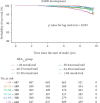Renal Complication and Glycemic Control in Korean Veterans with Type 2 Diabetes: A 10-Year Retrospective Cohort Study
- PMID: 32685562
- PMCID: PMC7333055
- DOI: 10.1155/2020/9806790
Renal Complication and Glycemic Control in Korean Veterans with Type 2 Diabetes: A 10-Year Retrospective Cohort Study
Abstract
Objective: Tight glycemic control reduces the risk of diabetes complications, but it may increase the risk of hypoglycemia or mortality in elderly patients. This study is aimed at evaluating the incidence and progression of renal complications and its association with glycemic control in elderly patients with type 2 diabetes.
Methods: This retrospective cohort study examined the data of 3099 patients with type 2 diabetes who were followed for at least 10 years at the Korean Veterans Hospital and for whom glycated hemoglobin (HbA1c) was measured in 2008 and 2017. Participants were divided into six groups according to their baseline or dynamic HbA1c levels. Extended Cox models were used to calculate adjusted hazard ratios for the development of chronic kidney disease (CKD) and end-stage renal disease (ESRD) associated with specific HbA1c ranges.
Results: During the 10-year follow-up period, 30% of patients developed new CKD, 50% showed progression, and ESRD developed in 1.7%. The risk of CKD was associated with baseline HbA1c from the first year of the study and dynamic HbA1c throughout the study period. The adjusted hazard ratios for CKD were 1.98 and 2.32 for baseline and dynamic HbA1c, respectively, at the level of ≥69 mmol/mol. There was no increased risk for any complications in baseline and dynamic HbA1c below 58 mmol/mol.
Conclusions: A higher HbA1c ≥ 58 mmol/mol was associated with an increased risk of diabetes complications. A less stringent glycemic target of HbA1c could be used as the threshold of renal complications.
Copyright © 2020 Ye An Kim et al.
Conflict of interest statement
All of the authors declare no conflict of interest.
Figures



References
-
- American Diabetes Association. Diagnosis and classification of diabetes mellitus. Diabetes Care. 2013;37(Supplement 1):S81–S90. - PubMed
-
- UK Prospective Diabetes Study (UKPDS) Group. Intensive blood-glucose control with sulphonylureas or insulin compared with conventional treatment and risk of complications in patients with type 2 diabetes (UKPDS 33) The Lancet. 1998;352(9131):837–853. - PubMed
MeSH terms
Substances
LinkOut - more resources
Full Text Sources
Medical
Miscellaneous

